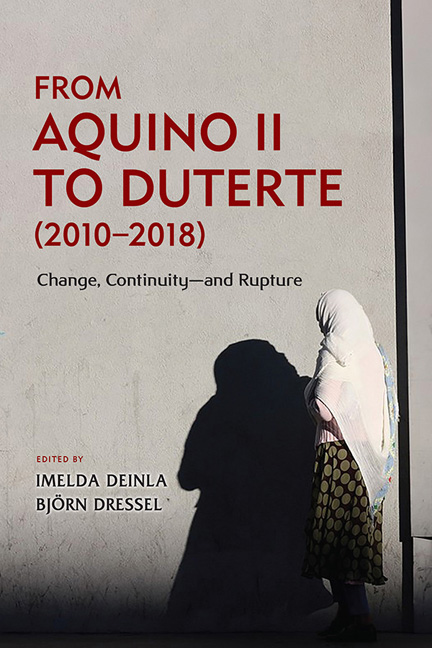Book contents
- Frontmatter
- Contents
- List of Tables
- List of Figures
- Acknowledgements
- Acronyms and Glossary
- Contributors
- Introduction: From Aquino II to Duterte (2010–2018): Change, Continuity—and Rupture 1
- PART I POLITICS AND GOVERNANCE
- 1 The Rise of Illiberal Democracy in the Philippines: Duterte's Early Presidency
- 2 Finding Federalism in the Philippines: Federalism—“The Centerpiece of My Campaign”
- 3 On Crooked Ways and Straight Paths: Assessing Anticorruption Governance of the Arroyo and Aquino Governments
- PART II ECONOMIC GOVERNANCE
- PART III PEACE PROCESS IN MINDANAO
- PART IV INTERNATIONAL ENVIRONMENT
- Index
3 - On Crooked Ways and Straight Paths: Assessing Anticorruption Governance of the Arroyo and Aquino Governments
from PART I - POLITICS AND GOVERNANCE
Published online by Cambridge University Press: 31 January 2020
- Frontmatter
- Contents
- List of Tables
- List of Figures
- Acknowledgements
- Acronyms and Glossary
- Contributors
- Introduction: From Aquino II to Duterte (2010–2018): Change, Continuity—and Rupture 1
- PART I POLITICS AND GOVERNANCE
- 1 The Rise of Illiberal Democracy in the Philippines: Duterte's Early Presidency
- 2 Finding Federalism in the Philippines: Federalism—“The Centerpiece of My Campaign”
- 3 On Crooked Ways and Straight Paths: Assessing Anticorruption Governance of the Arroyo and Aquino Governments
- PART II ECONOMIC GOVERNANCE
- PART III PEACE PROCESS IN MINDANAO
- PART IV INTERNATIONAL ENVIRONMENT
- Index
Summary
INTRODUCTION
Little progress has been made globally towards eliminating corruption. Former World Bank President Jim Yong Kim called public corruption— defined as misuse and abuse of public office for private gain—as “public enemy number one” owing to the profound impact on development and persistence of corruption despite resources channelled towards corruption control for decades. Developing countries still contend with pervasive corruption, and even governments of highly advanced economies are not spared from major corruption scandals. Transparency International reported in 2014 that corruption remains a major public policy issue in all regions of the world.
Frustrations over anticorruption strategies are captured by admissions of failure in the international anticorruption agenda. Based on an evaluation of the World Bank's public sector and governance reforms, Director General of the World Bank's Independent Evaluation Group, Vinod Thomas, lamented that “[d]irect measures to reduce corruption … rarely succeeded, as they often lacked the necessary support from political elites and the judicial system.” Technical approaches adopted in the past following the idea of corruption as a principal-agent problem shied away from addressing the highly political nature of corruption—reducing the effectiveness of such approaches to rhetoric. In response to inadequacies in theories of corruption and corruption control, some scholars started to conceptualize corruption as a collective action problem—whereby “everyone” will act corruptly if corruption is expected to be the norm. Alina Mungiu contends that traditional control of corruption fails because of a faulty assumption about the benevolence of principals to take up duties to control corruption. Institutionalists have fallen short of proposing possible solutions to the collective action problem by recommending losers of the “corrupt game” to come together to form an “insurrection army”—ignoring that corruption may be equally pervasive among civil society.
Empirical studies also do not offer directions for resolving the conceptualization debate. Some scholars support the assertion that political competition, economic prosperity and political leadership have attenuating effects on corruption. There is also evidence reinforcing the roles of professional and meritocratic bureaucracy, and administrative structure in controlling corruption. What appears to be lacking is a well-defined mechanism that determines the efficacy of these contextual factors against the incidence of corruption.
- Type
- Chapter
- Information
- From Aquino II to Duterte (2010–2018)Change, Continuity—and Rupture, pp. 99 - 124Publisher: ISEAS–Yusof Ishak InstitutePrint publication year: 2019

